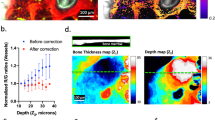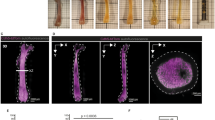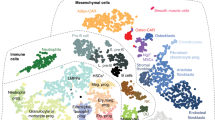Abstract
The bone marrow (BM) microenvironment contains many types of cells and molecules with roles in hematopoiesis, osteogenesis, angiogenesis and metabolism. The spatial distribution of the different bone and BM cell types remains elusive, owing to technical challenges associated with bone imaging. To map nonhematopoietic cells and structures in bone and BM, we performed multicolor 3D imaging of osteoblastic, vascular, perivascular, neuronal and marrow stromal cells, and extracellular-matrix proteins in whole mouse femurs. We analyzed potential interactions between cells and molecules on the basis of colocalization of markers. Our results shed light on the markers expressed by different osteolineage cell types; the heterogeneity of vascular and perivascular cells; the neural subtypes innervating marrow and bone; the diversity of stromal cells; and the distribution of extracellular-matrix components. Our complete imaging data set is available for download and can be used in research in bone biology, hematology, vascular biology, neuroscience and extracellular-matrix biology.
This is a preview of subscription content, access via your institution
Access options
Access Nature and 54 other Nature Portfolio journals
Get Nature+, our best-value online-access subscription
$29.99 / 30 days
cancel any time
Subscribe to this journal
Receive 12 print issues and online access
$209.00 per year
only $17.42 per issue
Buy this article
- Purchase on Springer Link
- Instant access to full article PDF
Prices may be subject to local taxes which are calculated during checkout






Similar content being viewed by others
References
Fliedner, T.M., Graessle, D., Paulsen, C. & Reimers, K. Structure and function of bone marrow hemopoiesis: mechanisms of response to ionizing radiation exposure. Cancer Biother. Radiopharm. 17, 405–426 (2002).
Maes, C. & Kronenberg, H.M. Postnatal bone growth: growth plate biology, bone formation, and remodeling. in Pediatric Bone: Biology & Diseases (eds. Glorieux, F.H. et al.) (Elsevier, 2012).
Morrison, S.J. & Scadden, D.T. The bone marrow niche for haematopoietic stem cells. Nature 505, 327–334 (2014).
Magnon, C. & Frenette, P.S. Hematopoietic stem cell trafficking. StemBook http://dx.doi.org/10.3824/stembook.1.8.1 (2008).
Deschaseaux, F., Pontikoglou, C. & Sensébé, L. Bone regeneration: the stem/progenitor cells point of view. J. Cell. Mol. Med. 14, 103–115 (2010).
Mach, D.B. et al. Origins of skeletal pain: sensory and sympathetic innervation of the mouse femur. Neuroscience 113, 155–166 (2002).
Gattazzo, F., Urciuolo, A. & Bonaldo, P. Extracellular matrix: a dynamic microenvironment for stem cell niche. Biochim. Biophys. Acta 1840, 2506–2519 (2014).
Tavassoli, M. & Friedenstein, A. Hemopoietic stromal microenvironment. Am. J. Hematol. 15, 195–203 (1983).
Coutu, D.L., Kokkaliaris, K.D., Kunz, L. & Schroeder, T. Multicolor quantitative confocal imaging cytometry. Nat. Methods http://dx.doi.org/10.1038/nmeth.4503 (2017).
Aubin, J.E. Advances in the osteoblast lineage. Biochem. Cell Biol. 76, 899–910 (1998).
Elefteriou, F. & Yang, X. Genetic mouse models for bone studies: strengths and limitations. Bone 49, 1242–1254 (2011).
Karsenty, G., Kronenberg, H.M. & Settembre, C. Genetic control of bone formation. Annu. Rev. Cell Dev. Biol. 25, 629–648 (2009).
Kronenberg, H.M. Developmental regulation of the growth plate. Nature 423, 332–336 (2003).
Dominici, M. et al. Minimal criteria for defining multipotent mesenchymal stromal cells: The International Society for Cellular Therapy position statement. Cytotherapy 8, 315–317 (2006).
Méndez-Ferrer, S. et al. Mesenchymal and haematopoietic stem cells form a unique bone marrow niche. Nature 466, 829–834 (2010).
Kunisaki, Y. et al. Arteriolar niches maintain haematopoietic stem cell quiescence. Nature 502, 637–643 (2013).
Morikawa, S. et al. Prospective identification, isolation, and systemic transplantation of multipotent mesenchymal stem cells in murine bone marrow. J. Exp. Med. 206, 2483–2496 (2009).
Bilic-Curcic, I. et al. Visualizing levels of osteoblast differentiation by a two-color promoter-GFP strategy: type I collagen-GFPcyan and osteocalcin-GFPtpz. Genesis 43, 87–98 (2005).
Ono, N. et al. Vasculature-associated cells expressing nestin in developing bones encompass early cells in the osteoblast and endothelial lineage. Dev. Cell 29, 330–339 (2014).
Eswarakumar, V.P. et al. The IIIc alternative of Fgfr2 is a positive regulator of bone formation. Development 129, 3783–3793 (2002).
Kopp, H.-G., Avecilla, S.T., Hooper, A.T. & Rafii, S. The bone marrow vascular niche: home of HSC differentiation and mobilization. Physiology (Bethesda) 20, 349–356 (2005).
Weiss, L. The hematopoietic microenvironment of the bone marrow: an ultrastructural study of the stroma in rats. Anat. Rec. 186, 161–184 (1976).
Tavassoli, M. & Weiss, L. The structure of developing bone marrow sinuses in extramedullary autotransplant of the marrow in rats. Anat. Rec. 171, 477–494 (1971).
De Bruyn, P.P., Breen, P.C. & Thomas, T.B. The microcirculation of the bone marrow. Anat. Rec. 168, 55–68 (1970).
Branemark, P.I. Vital microscopy of bone marrow in rabbit. Scand. J. Clin. Lab. Invest. 11 Supp 38, 1–82 (1959).
van Mourik, J.A., Leeksma, O.C., Reinders, J.H., de Groot, P.G. & Zandbergen-Spaargaren, J. Vascular endothelial cells synthesize a plasma membrane protein indistinguishable from the platelet membrane glycoprotein IIa. J. Biol. Chem. 260, 11300–11306 (1985).
Lampugnani, M.G. et al. A novel endothelial-specific membrane protein is a marker of cell-cell contacts. J. Cell Biol. 118, 1511–1522 (1992).
Fina, L. et al. Expression of the CD34 gene in vascular endothelial cells. Blood 75, 2417–2426 (1990).
Gougos, A. & Letarte, M. Identification of a human endothelial cell antigen with monoclonal antibody 44G4 produced against a pre-B leukemic cell line. J. Immunol. 141, 1925–1933 (1988).
Hooper, A.T. et al. Engraftment and reconstitution of hematopoiesis is dependent on VEGFR2-mediated regeneration of sinusoidal endothelial cells. Cell Stem Cell 4, 263–274 (2009).
Hallmann, R., Mayer, D.N., Berg, E.L., Broermann, R. & Butcher, E.C. Novel mouse endothelial cell surface marker is suppressed during differentiation of the blood brain barrier. Dev. Dyn. 202, 325–332 (1995).
Morgan, S.M., Samulowitz, U., Darley, L., Simmons, D.L. & Vestweber, D. Biochemical characterization and molecular cloning of a novel endothelial-specific sialomucin. Blood 93, 165–175 (1999).
Kusumbe, A.P., Ramasamy, S.K. & Adams, R.H. Coupling of angiogenesis and osteogenesis by a specific vessel subtype in bone. Nature 507, 323–328 (2014).
Lin, G., Finger, E. & Gutierrez-Ramos, J.C. Expression of CD34 in endothelial cells, hematopoietic progenitors and nervous cells in fetal and adult mouse tissues. Eur. J. Immunol. 25, 1508–1516 (1995).
Pusztaszeri, M.P., Seelentag, W. & Bosman, F.T. Immunohistochemical expression of endothelial markers CD31, CD34, von Willebrand factor, and Fli-1 in normal human tissues. J. Histochem. Cytochem. 54, 385–395 (2006).
Ding, L., Saunders, T.L., Enikolopov, G. & Morrison, S.J. Endothelial and perivascular cells maintain haematopoietic stem cells. Nature 481, 457–462 (2012).
Zhou, B.O., Yue, R., Murphy, M.M., Peyer, J.G. & Morrison, S.J. Leptin-receptor-expressing mesenchymal stromal cells represent the main source of bone formed by adult bone marrow. Cell Stem Cell 15, 154–168 (2014).
Yamazaki, S. et al. Nonmyelinating Schwann cells maintain hematopoietic stem cell hibernation in the bone marrow niche. Cell 147, 1146–1158 (2011).
Afan, A.M., Broome, C.S., Nicholls, S.E., Whetton, A.D. & Miyan, J.A. Bone marrow innervation regulates cellular retention in the murine haemopoietic system. Br. J. Haematol. 98, 569–577 (1997).
Tabarowski, Z., Gibson-Berry, K. & Felten, S.Y. Noradrenergic and peptidergic innervation of the mouse femur bone marrow. Acta Histochem. 98, 453–457 (1996).
McKee, M.D., Addison, W.N. & Kaartinen, M.T. Hierarchies of extracellular matrix and mineral organization in bone of the craniofacial complex and skeleton. Cells Tissues Organs 181, 176–188 (2005).
Allori, A.C., Sailon, A.M., Pan, J.H. & Warren, S.M. Biological basis of bone formation, remodeling, and repair-part III: biomechanical forces. Tissue Eng. Part B Rev. 14, 285–293 (2008).
Boxall, S.A. & Jones, E. Markers for characterization of bone marrow multipotential stromal cells. Stem Cells Int. 2012, 975871 (2012).
Justesen, J. et al. Adipocyte tissue volume in bone marrow is increased with aging and in patients with osteoporosis. Biogerontology 2, 165–171 (2001).
Ara, T. et al. Long-term hematopoietic stem cells require stromal cell-derived factor-1 for colonizing bone marrow during ontogeny. Immunity 19, 257–267 (2003).
Westen, H. & Bainton, D.F. Association of alkaline-phosphatase-positive reticulum cells in bone marrow with granulocytic precursors. J. Exp. Med. 150, 919–937 (1979).
Nombela-Arrieta, C. et al. Quantitative imaging of haematopoietic stem and progenitor cell localization and hypoxic status in the bone marrow microenvironment. Nat. Cell Biol. 15, 533–543 (2013).
Acar, M. et al. Deep imaging of bone marrow shows non-dividing stem cells are mainly perisinusoidal. Nature 526, 126–130 (2015).
Bradbury, A. & Plückthun, A. Reproducibility: standardize antibodies used in research. Nature 518, 27–29 (2015).
Baker, M. Reproducibility crisis: blame it on the antibodies. Nature 521, 274–276 (2015).
Mignone, J.L., Kukekov, V., Chiang, A.-S., Steindler, D. & Enikolopov, G. Neural stem and progenitor cells in nestin-GFP transgenic mice. J. Comp. Neurol. 469, 311–324 (2004).
Park, E.J. et al. An FGF autocrine loop initiated in second heart field mesoderm regulates morphogenesis at the arterial pole of the heart. Development 135, 3599–3610 (2008).
Rodda, S.J. & McMahon, A.P. Distinct roles for Hedgehog and canonical Wnt signaling in specification, differentiation and maintenance of osteoblast progenitors. Development 133, 3231–3244 (2006).
Maes, C. et al. Osteoblast precursors, but not mature osteoblasts, move into developing and fractured bones along with invading blood vessels. Dev. Cell 19, 329–344 (2010).
Madisen, L. et al. A robust and high-throughput Cre reporting and characterization system for the whole mouse brain. Nat. Neurosci. 13, 133–140 (2010).
Sanjuan-Pla, A. et al. Platelet-biased stem cells reside at the apex of the haematopoietic stem-cell hierarchy. Nature 502, 232–236 (2013).
Schindelin, J. et al. Fiji: an open-source platform for biological-image analysis. Nat. Methods 9, 676–682 (2012).
Acknowledgements
This study was supported in part by the SystemsX StemSysMed grant to T.S.
Author information
Authors and Affiliations
Contributions
D.L.C. developed the method with K.D.K. and L.K. D.L.C. and K.D.K. designed the project. K.D.K., D.L.C. and L.K. performed the experiments. D.L.C. performed the analyses. D.L.C., K.D.K. and T.S. wrote the manuscript, on which all authors commented. T.S. obtained funding and supervised the project.
Corresponding author
Ethics declarations
Competing interests
The authors declare no competing financial interests.
Integrated supplementary information
Supplementary Figure 1 Display of colocalization analysis results.
The Coloc module of Imaris was used for voxel colocalization analyses. The software tools were used to select thresholds for two given markers (marker A and B here), which are indicated by the red box. The value given by x represents the percentage of voxels with a fluorescence intensity for marker A above the threshold that also have a fluorescence intensity for marker B above threshold. Inversely, the value given by y represents the percentage of voxels with a fluorescence intensity for marker B above the threshold that also have a fluorescence intensity for marker A above threshold. The colocalization data presented is derived from the full or partial image (see figure legends for details) shown in the same figure panel.
Supplementary Figure 2 Identification of distinct anatomical locations and cell types in adult mouse femurs without landmark staining.
a) Examples showing how to identify trabecular (i) and cortical (ii) bone surfaces, as well as growth plate (iii) and articular (iv) cartilage using only a vascular marker (collagen 1 is here shown to validate proper identification). i) Trabecular bone in the metaphyseal area can be identified by the complete absence of vascular sinusoids (dotted lines) although it can be irrigated by rare arterioles or capillaries (arrowheads). ii) Similarly, cortical bone shows a complete absence of sinusoids but is traversed by some arterioles (not shown). At the bone surface (dotted line), vasculature consists of capillaries running parallel to the long axis of the bone (arrowheads), as opposed to the central marrow where mainly sinusoids are present and radiate axially from the center of the marrow cavity. iii, iv) Growth plate and articular cartilage show a complete absence of vasculature and are located in very specific anatomical locations. b) Adipocytes and megakaryocytes can be difficult to distinguish by inexperienced researchers without specific staining. However, adipocytes are typically bigger and rounder than megakaryocytes. Also, a cytoplasmic staining in adipocytes clearly shows a lack of staining in the large lipid droplet (upper left) whereas a lipid droplet staining shows a smaller spherical staining (lower left). Cytoplasmic (upper right) or membrane (lower right) stainings in megakaryocytes shows cells with irregular shapes, in many of which we can observe multiple/complex nuclei (arrowheads).
Supplementary Figure 3 Some Nes-GFP-expressing cells are ALP+CD31− osteoblastic cells.
Images show a zoom of data presented in Figure 2b and only four optical sections (total thickness 9.96μm). Near the distal growth plate of the femur, Nes-GFP expressing cells (green, white arrowheads) are closely associated with CD31+ blood vessels (red), but are osteoblastic cells expressing ALP (grey). Scale bars: 20μm
Supplementary Figure 4 Osx-CreERT (tdTomato) reporter shows a similar expression pattern to that of the Osx-GFP reporter.
7 weeks old female Osx-CreERT mice received 2mg 4-hydroxytamoxifen intraperitoneally and femurs were harvested three days later. Expression of the tdTomato reporter at day 3 post-4OHT recapitulates that of the Osx-GFP reporter (see figure 2c). Scale bar of detail 70μm.
Supplementary Figure 5 Antibody staining for osteocalcin partially overlaps with OC-YFP expression.
Images show a zoom of data presented in Figure 2e and only four optical sections (total thickness 9.96μm). Near the distal growth plate of the femur, OC-YFP expressing cells (green, white arrowheads) line collagen 1+ (grey) trabecular bone surfaces and stain positive for osteocalcin antibody (red). Osteocalcin antibody also detects OC+ matrix away from YFP+ cells in trabecular bone and adjacent to the growth plate (black arrowheads). Scale bars: 30μm
Supplementary Figure 6 Expression of mesenchymal-progenitor-cell markers near the distal growth plate.
Images show a zoom of data presented in Figure 2f and only four optical sections (total thickness 9.96μm). We can observe CD140a+Sca1+ cells lining CD31+ blood vessels (white arrowheads), whereas bone lining cells are either FGFR2+ (black arrowheads) or FGFR2+CD140a+ (white arrows). Scale bars 20 μm.
Supplementary Figure 7 CD105 is not a panendothelial marker.
(i) Most arterioles do not express CD105, but only CD31 and Sca1 (white arrowheads) potentially marking distinct arteriolar sub-types. (ii) Diaphyseal arteries marked by SM22 expression are CD105-CD31+Sca1+. (iii) Strong CD105 expression in the endothelial wall of the central sinus.
Supplementary information
Supplementary Text and Figures
Supplementary Figures 1–7 and Supplementary Tables 1–3 (PDF 2345 kb)
Rights and permissions
About this article
Cite this article
Coutu, D., Kokkaliaris, K., Kunz, L. et al. Three-dimensional map of nonhematopoietic bone and bone-marrow cells and molecules. Nat Biotechnol 35, 1202–1210 (2017). https://doi.org/10.1038/nbt.4006
Received:
Accepted:
Published:
Issue Date:
DOI: https://doi.org/10.1038/nbt.4006
This article is cited by
-
Profound sympathetic neuropathy in the bone marrow of patients with acute myeloid leukemia
Leukemia (2024)
-
Mesenchymal stromal cell-associated migrasomes: a new source of chemoattractant for cells of hematopoietic origin
Cell Communication and Signaling (2023)
-
Breast cancer remotely imposes a myeloid bias on haematopoietic stem cells by reprogramming the bone marrow niche
Nature Cell Biology (2023)
-
Expansion of human megakaryocyte-biased hematopoietic stem cells by biomimetic Microniche
Nature Communications (2023)
-
Reassessing endothelial-to-mesenchymal transition in mouse bone marrow: insights from lineage tracing models
Nature Communications (2023)



